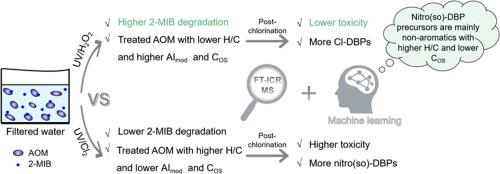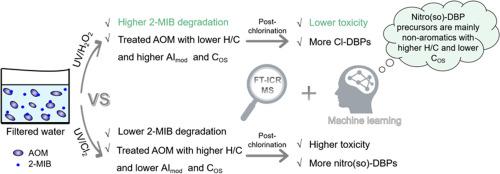Investigation of nitro(so)- and chloro-disinfection byproduct formation mechanisms after UV/Cl2 and UV/H2O2 oxidation of 2-methylisoborneol in the presence of algal organic matter
IF 12.4
1区 环境科学与生态学
Q1 ENGINEERING, ENVIRONMENTAL
引用次数: 0
Abstract
Cyanobacterial blooms, such as Pseudanabaena bloom, pose considerable risks to drinking water quality due to the release of odorants like 2-methylisoborneol (2-MIB). Although preoxidation-enhanced coagulation efficiently removes Pseudanabaena cells and intracellular 2-MIB, substantial amounts of extracellular 2-MIB persist after coagulation and filtration, posing ongoing challenges to drinking water safety. This study compared the performance of UV/H2O2 and UV/Cl2 oxidation for removing 2-MIB in the presence of algal organic matter (AOM) within the filtered water, and evaluated their impacts on subsequent chlorination-induced disinfection byproduct (DBP) formation and water toxicity. UV/H2O2 oxidation achieved a higher 2-MIB degradation efficiency (98.1%) compared with UV/Cl2 oxidation (85.6%), while exhibiting lower post-chlorination toxicity. UV/Cl2 treatment led to a marked increase in toxicity after subsequent chlorination, primarily attributed to the formation of highly toxic nitro and nitroso DBPs (nitro(so)-DBPs). Comprehensive analysis of chlorinated DBPs (Cl-DBPs) (i.e., (semi-)volatile and macromolecular Cl-DBPs) and nitro(so)-DBPs revealed that chlorination of UV/H2O2-treated samples generated more Cl-DBPs, whereas chlorination of UV/Cl2-treated samples favoured the formation of nitro(so)-DBPs. These results highlight the important contribution of nitro(so)-DBPs to AOM-derived DBP toxicity. Fourier-transform ion cyclotron resonance mass spectrometry (FT-ICR MS) combined with machine learning identified key molecular descriptors — comprising modified aromatic index, ratio of hydrogen to carbon (H/C), and carbon oxidation state (COS) — as predictive features for DBP formation. Our results indicate that, compared with Cl-DBP precursors, nitro(so)-DBP precursors are mainly non-aromatics with higher H/C and lower COS. This is the first study to incorporate nitro(so)-DBPs into the AOM-derived DBP evaluation framework and to systematically differentiate their formation mechanisms from those of Cl-DBPs.


藻类有机物存在下2-甲基异龙脑UV/Cl2和UV/H2O2氧化后硝基消毒副产物和氯消毒副产物形成机制的研究
蓝藻华,如假藻华,由于释放2-甲基异冰片醇(2-MIB)等气味剂,对饮用水质量构成相当大的风险。虽然预氧化强化混凝能有效去除假藻细胞和细胞内2-MIB,但在混凝和过滤后,细胞外2-MIB仍大量存在,对饮用水安全构成持续挑战。本研究比较了在过滤水中存在藻类有机物(AOM)的情况下,UV/H2O2和UV/Cl2氧化去除2-MIB的性能,并评估了它们对随后氯化诱导的消毒副产物(DBP)形成和水毒性的影响。与UV/Cl2氧化(85.6%)相比,UV/H2O2氧化获得了更高的2-MIB降解效率(98.1%),同时表现出更低的氯化后毒性。UV/Cl2处理导致随后氯化后毒性显著增加,主要是由于形成剧毒的硝基和亚硝基DBPs(硝基(so)-DBPs)。对氯化DBPs (Cl-DBPs)(即(半)挥发性和大分子Cl-DBPs)和硝基(so)-DBPs的综合分析表明,UV/ h2o2处理样品的氯化处理产生更多的Cl-DBPs,而UV/ cl2处理样品的氯化处理有利于硝基(so)-DBPs的形成。这些结果强调了硝基(so)-DBP对aom衍生的DBP毒性的重要贡献。傅里叶变换离子回旋共振质谱(FT-ICR MS)结合机器学习确定了关键的分子描述符——包括修饰的芳香指数、氢碳比(H/C)和碳氧化态(COS)——作为DBP形成的预测特征。结果表明,与Cl-DBP前驱体相比,硝基(so)-DBP前驱体以非芳烃为主,具有较高的H/C和较低的COS。这是首次将硝基(so)-DBP纳入aom衍生DBP评估框架,并系统区分其与cl -DBP形成机制的研究。
本文章由计算机程序翻译,如有差异,请以英文原文为准。
求助全文
约1分钟内获得全文
求助全文
来源期刊

Water Research
环境科学-工程:环境
CiteScore
20.80
自引率
9.40%
发文量
1307
审稿时长
38 days
期刊介绍:
Water Research, along with its open access companion journal Water Research X, serves as a platform for publishing original research papers covering various aspects of the science and technology related to the anthropogenic water cycle, water quality, and its management worldwide. The audience targeted by the journal comprises biologists, chemical engineers, chemists, civil engineers, environmental engineers, limnologists, and microbiologists. The scope of the journal include:
•Treatment processes for water and wastewaters (municipal, agricultural, industrial, and on-site treatment), including resource recovery and residuals management;
•Urban hydrology including sewer systems, stormwater management, and green infrastructure;
•Drinking water treatment and distribution;
•Potable and non-potable water reuse;
•Sanitation, public health, and risk assessment;
•Anaerobic digestion, solid and hazardous waste management, including source characterization and the effects and control of leachates and gaseous emissions;
•Contaminants (chemical, microbial, anthropogenic particles such as nanoparticles or microplastics) and related water quality sensing, monitoring, fate, and assessment;
•Anthropogenic impacts on inland, tidal, coastal and urban waters, focusing on surface and ground waters, and point and non-point sources of pollution;
•Environmental restoration, linked to surface water, groundwater and groundwater remediation;
•Analysis of the interfaces between sediments and water, and between water and atmosphere, focusing specifically on anthropogenic impacts;
•Mathematical modelling, systems analysis, machine learning, and beneficial use of big data related to the anthropogenic water cycle;
•Socio-economic, policy, and regulations studies.
 求助内容:
求助内容: 应助结果提醒方式:
应助结果提醒方式:


